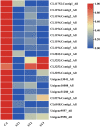Biochemical and transcriptomic analyses of the symbiotic interaction between Cremastra appendiculata and the mycorrhizal fungus Coprinellus disseminatus
- PMID: 34983403
- PMCID: PMC8725509
- DOI: 10.1186/s12870-021-03388-6
Biochemical and transcriptomic analyses of the symbiotic interaction between Cremastra appendiculata and the mycorrhizal fungus Coprinellus disseminatus
Abstract
Background: Cremastra appendiculata is a rare terrestrial orchid with a high market value as an ornamental and medicinal plant. However, the species depends entirely on fungi for seed germination under natural conditions. In a previous study, we have successfully isolated and identified the mycorrhizal fungus Coprinellus disseminatus which was able to induce the germination of C. appendiculata seeds. We then speculated that C. disseminatus may do so by breaking the testa imposed dormancy of the seeds. In this study, biochemical and transcriptomic analyses were used to characterize the germination of C. appendiculata seeds, collected at different stages of germination, as affected by C. disseminatus.
Results: The lignocellulose in the seeds coat of C. appendiculata was degraded by the mycorrhizal fungus resulting in facilitated absorption of water. The rate of decline in lignin content was 67 and 73% at 6 and 12 days after sowing, respectively. The water content increased from 13 to 90% during symbiosis. A total of 15,382 genes showing significantly different levels of expression (log2 FPKM≥2.0, Qvalue≤0.05) were successfully identified among all libraries, where the highest number of DEGs was shared between 6 days versus 0 day after symbiotic germination. Gene annotation results suggested that 15 key genes related water-status, such as DHN gene family and Xero 1 were down-regulated. The genes zeaxanthin epoxidase ZEP, 9-cis-epoxycarotenoid dioxygenase NCED3 and β-carotene hydroxylase involved in the biosynthesis of abscisic acid (ABA) were significantly down-regulated in 6 days as compared to 0 day after symbiotic germination.
Conclusions: This work demonstrates that mycorrhizal fungus C. disseminatus can stimulate C. appendiculata seeds germination through a mechanism of breaking the testa imposed dormancy and inducing water absorption of the embryo.
Keywords: Coprinellus disseminatus; Cremastra appendiculata; Lignin degradation; Seed germination; Transcriptome analysis.
© 2022. The Author(s).
Conflict of interest statement
The authors declare that the research was conducted without any commercial or financial relationship that constructed as a potential conflict of interest.
Figures





Similar articles
-
Identification and symbiotic ability of Psathyrellaceae fungi isolated from a photosynthetic orchid, Cremastra appendiculata (Orchidaceae).Am J Bot. 2013 Sep;100(9):1823-30. doi: 10.3732/ajb.1300099. Epub 2013 Sep 11. Am J Bot. 2013. PMID: 24026354
-
Enhancing Seed Germination of Cremastra appendiculata: Screening and Identification of Four New Symbiotic Fungi in the Psathyrellaceae Family.J Microbiol. 2024 Aug;62(8):671-682. doi: 10.1007/s12275-024-00148-7. Epub 2024 Jun 28. J Microbiol. 2024. PMID: 38940992
-
Functional Insights into the Roles of Hormones in the Dendrobium officinale-Tulasnella sp. Germinated Seed Symbiotic Association.Int J Mol Sci. 2018 Nov 6;19(11):3484. doi: 10.3390/ijms19113484. Int J Mol Sci. 2018. PMID: 30404159 Free PMC article.
-
Further advances in orchid mycorrhizal research.Mycorrhiza. 2007 Sep;17(6):475-486. doi: 10.1007/s00572-007-0138-1. Epub 2007 Jun 21. Mycorrhiza. 2007. PMID: 17582535 Review.
-
Deception above, deception below: linking pollination and mycorrhizal biology of orchids.J Exp Bot. 2008;59(5):1085-96. doi: 10.1093/jxb/erm366. Epub 2008 Mar 2. J Exp Bot. 2008. PMID: 18316318 Review.
Cited by
-
Transcriptomic and protein-protein interaction network analyses of the molecular mechanisms underlying the mycorrhizal interaction in Cypripedium macranthos var. rebunense.Front Plant Sci. 2025 Jul 10;16:1597154. doi: 10.3389/fpls.2025.1597154. eCollection 2025. Front Plant Sci. 2025. PMID: 40708584 Free PMC article.
-
Comparative transcriptomics and proteomics analysis of the symbiotic germination of Paphiopedilum barbigerum with Epulorhiza sp. FQXY019.Front Microbiol. 2024 Mar 18;15:1358137. doi: 10.3389/fmicb.2024.1358137. eCollection 2024. Front Microbiol. 2024. PMID: 38562471 Free PMC article.
-
Saline-alkali resilience: the role of Trametes NF1 in promoting alfalfa growth and salinity tolerance.Int Microbiol. 2025 Jun 4. doi: 10.1007/s10123-025-00680-5. Online ahead of print. Int Microbiol. 2025. PMID: 40465068
-
LC-HRMS/MS-Based Metabolomics Approaches Applied to the Detection of Antifungal Compounds and a Metabolic Dynamic Assessment of Orchidaceae.Molecules. 2022 Nov 16;27(22):7937. doi: 10.3390/molecules27227937. Molecules. 2022. PMID: 36432039 Free PMC article.
-
Perspective and challenges of mycorrhizal symbiosis in orchid medicinal plants.Chin Herb Med. 2024 Mar 8;16(2):172-179. doi: 10.1016/j.chmed.2024.03.001. eCollection 2024 Apr. Chin Herb Med. 2024. PMID: 38706832 Free PMC article. Review.
References
-
- Agnihotri S, Dutt D, Tyagi CH, Kumar A, Upadhyaya JS. Production and biochemical characterization of a novel cellulase-poor alkali-thermo-tolerant xylanase from Coprinellus disseminatus SW-1 NTCC 1165. World J Microbiol Biotechnol. 2010;26(8):1349–1359.
-
- Barsberg S, Rasmussen HN, Kodahl N. Composition of Cypripedium calceolus (Orchidaceae) seeds analyzed by attenuated total reflectance IR spectroscopy: in search of understanding longevity in the ground. Am J Bot. 2013;100(10):2066–2073. - PubMed
-
- Barsberg ST, Lee YI, Rasmussen HN. Development of C-lignin with G/S-lignin and lipids in orchid seed coats-an unexpected diversity exposed by ATR-FT-IR spectroscopy. Seed Sci Res. 2018;28(1):41–51.
-
- Baskin CC. Breaking physical dormancy in seeds-focussing on the lens. New Phytol. 2003;158:227–238.
MeSH terms
Substances
Supplementary concepts
LinkOut - more resources
Full Text Sources

